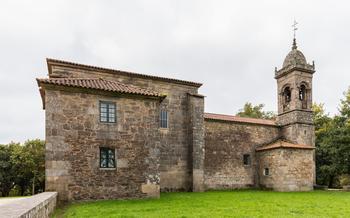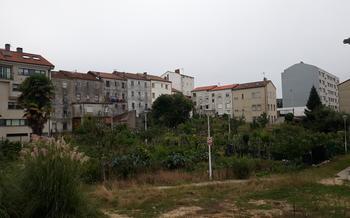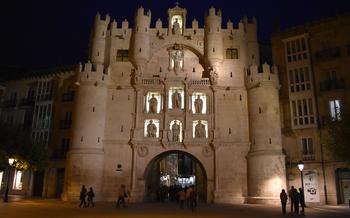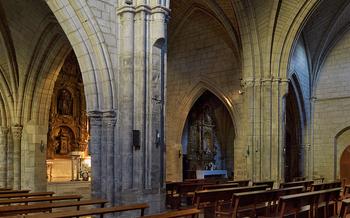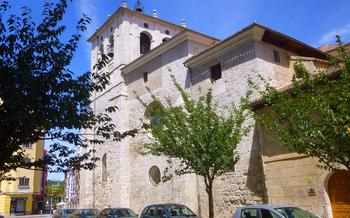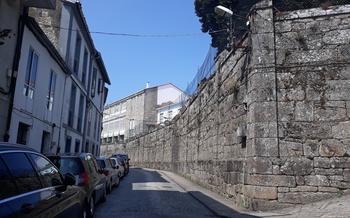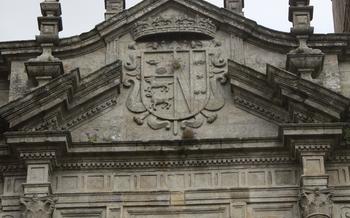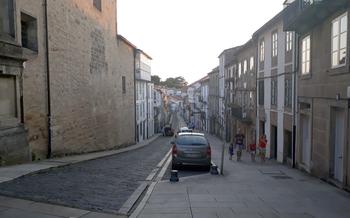
Iglesia de San Pedro de la Fuente
- The Church of San Pedro de la Fuente, a Romanesque Gem
- A Journey Through Time:
- Unveiling the Interior:
- Highlights of the Altars:
- The Cloister's Serenity:
- San Pedro's Festival: A Celebration of Faith and Community
- The Legendary Battle of San Pedro
- Visiting Hours and Practical Information
- Accommodation and Dining Options
- Festivals and Events
- Insider Tip: Secret Spots and Unforgettable Experiences
The Church of San Pedro de la Fuente, a Romanesque Gem
The Church of San Pedro de la Fuente, nestled along the banks of the Arlanzón River, stands as a testament to the rich cultural heritage of Burgos, Spain. With its origins dating back to the 12th century, this Romanesque masterpiece holds a significant place in the city's history. The church's unique architectural features, intricate carvings, and symbolic elements create a harmonious blend of art, history, and spirituality. As a symbol of devotion and a treasure trove of Romanesque art, San Pedro de la Fuente invites visitors to embark on a journey through time and experience the enduring beauty and significance of this sacred space.
The church's exterior captivates with its stunning apse, adorned with intricate carvings depicting biblical scenes and mythical creatures. The majestic bell tower, a symbol of strength and resilience, offers panoramic views of the picturesque city. The decorative elements and sculptures adorning the facade provide a glimpse into the artistic prowess and symbolism of the Romanesque era, inviting visitors to explore the hidden meanings and stories embedded in the church's design.
A Journey Through Time:
The Iglesia de San Pedro de la Fuente embarks visitors on a journey through time, showcasing the evolution of architectural styles and their significance in the church's history. Originally built in the 11th century, the church stands as a testament to the Romanesque style, with its characteristic rounded arches, thick walls, and intricate carvings. Over the centuries, the church underwent several modifications and expansions, blending elements of Gothic and Renaissance styles.
During the 15th century, the impressive bell tower was constructed, adding a vertical element to the church's profile and offering panoramic city views. In the 16th century, the cloister was built, providing a tranquil space for contemplation and reflection. Restoration efforts in the 19th and 20th centuries aimed to preserve the church's original features while ensuring its structural integrity, allowing visitors to appreciate its architectural heritage.
The impact of historical events can be felt throughout the church. During the Middle Ages, it served as a refuge for pilgrims on the Camino de Santiago, offering shelter and spiritual comfort. The legendary Battle of San Pedro, fought in the 11th century, left its mark on the church, with local legends and folklore surrounding the event. These historical layers add depth and intrigue to the church, inviting visitors to explore its connections to the past.
Unveiling the Interior:
Stepping inside the Iglesia de San Pedro de la Fuente is like stepping into a sacred realm of art and history. The church's interior is adorned with captivating frescoes and murals that depict biblical scenes and stories from the lives of saints. These vibrant artworks bring the walls to life, creating a sense of awe and wonder.
The stunning stained glass windows are another highlight of the church's interior. They bathe the space in a kaleidoscope of colors, casting intricate patterns on the floor and illuminating the intricate details of the carvings. Each window tells a unique story, inviting visitors to contemplate the mysteries of faith and the beauty of creation.
Carefully crafted altars line the interior of the church, each one a masterpiece of artistry and craftsmanship. The main altar, with its intricate carvings and gleaming gold leaf, is a sight to behold. It features a stunning altarpiece depicting scenes from the life of Christ, surrounded by a chorus of sculpted angels and saints.
The unique iconography and religious art found throughout the church's interior add to its spiritual significance. From the symbolic representations of the Trinity to the delicate depictions of the Virgin Mary, every detail has been carefully considered to convey a message of faith and devotion.
Highlights of the Altars:
The main altar of the Iglesia de San Pedro de la Fuente is a true masterpiece of Romanesque art, captivating visitors with its intricate carvings and rich symbolism. The altarpiece, dedicated to Saint Peter, the patron saint of the church, is a testament to the artistic skill and craftsmanship of the period.
Crafted from polychromed wood, the altar features a central panel depicting scenes from the life of Saint Peter, including his calling by Jesus, his denial of Christ, and his crucifixion. The vibrant colors and expressive figures bring the biblical narratives to life, inviting viewers to contemplate the significance of Saint Peter's role in the early Christian church.
Flanking the central panel are two smaller panels, each adorned with delicate carvings of saints and biblical figures. The attention to detail and the harmonious composition of the altar create a sense of awe and reverence, highlighting the importance of this sacred space.
The symbolism embedded within the altar's iconography adds depth and meaning to the artwork. The scallop shell, a symbol of pilgrimage, is prominently displayed, representing the church's significance on the Camino de Santiago. The grapes and vine motifs symbolize the Eucharist, reminding visitors of the sacrificial love of Christ.
Overall, the main altar of the Iglesia de San Pedro de la Fuente is a testament to the enduring legacy of Romanesque art, showcasing the artistic prowess and spiritual devotion of the medieval period. It invites visitors to explore the rich symbolism and intricate narratives that adorn this sacred space, deepening their understanding of the church's historical and cultural significance.
The Cloister's Serenity:
Step into the serene embrace of the cloister garden, a tranquil haven nestled within the walls of San Pedro de la Fuente. This cloister, with its peaceful ambiance and intricate carvings, offers a sanctuary from the bustling city streets. Wander amidst the manicured lawns, where the gentle sound of birdsong fills the air. Admire the delicate carvings adorning the cloister's arches and columns, each depicting scenes from biblical stories and the lives of saints.
The cloister served as a place of contemplation and meditation for the monks who once resided here. Its serene atmosphere invites visitors to pause and reflect, to find solace and inspiration within these sacred grounds. In the center of the cloister, a fountain trickles softly, adding to the tranquility of the space. Take a moment to sit on one of the stone benches and soak in the tranquility, allowing the beauty of the surroundings to wash away your worries.
The cloister also holds historical significance, having been a place of gathering and learning for the monks. Here, they would discuss religious texts, engage in scholarly pursuits, and tend to the practical matters of running the monastery. Its serene ambiance and rich history make the cloister a must-visit for anyone seeking a moment of peace and contemplation in the heart of Burgos.
San Pedro's Festival: A Celebration of Faith and Community
The annual San Pedro's Festival, held in honor of the church's patron saint, is a vibrant and joyous celebration that brings the community together. During this festive period, the streets of Burgos come alive with music, laughter, and colorful processions. The festival's highlight is the traditional procession, where the statue of San Pedro is carried through the city's streets, accompanied by local bands, choirs, and enthusiastic participants. The procession is a spectacle of devotion and spectacle, showcasing the deep religious and cultural traditions of Burgos.
Beyond the processions, the festival offers a variety of cultural events, including traditional dances, folk music performances, and art exhibitions. Local artisans and vendors set up stalls, showcasing their handmade crafts and regional delicacies. The festival provides a unique opportunity to immerse oneself in the rich culture of Burgos, savor local cuisine, and witness the deep-rooted traditions that have been passed down through generations.
The Legendary Battle of San Pedro
In the annals of Burgos history, the silent witness to a legendary battle that forever etched its name in the city's lore. The Battle of San Pedro, fought in 1074, pitted the forces of King Alfonso VI of Castile against the formidable army of Sancho II of León. The clash took place on the grounds of the church, transforming its sacred space into a battlefield.
According to local legend, the battle was a desperate struggle for power and territory. King Alfonso, determined to unite the kingdoms under his rule, faced the challenge of his ambitious brother, Sancho II. The stakes were high, and the outcome would shape the destiny of the region.
As the two armies clashed in a fierce combat, the church became a sanctuary for the wounded and a refuge for the faithful. The sound of battle echoed through its hallowed halls, and the cries of fallen soldiers mingled with the prayers of those seeking divine protection.
In the end, King Alfonso emerged victorious, securing his claim to the throne and establishing the foundations of a unified Castile. The Battle of San Pedro became a turning point in the history of Burgos, forever linking the church with the city's struggle for independence and sovereignty.
To this day, the legacy of the battle lives on in the hearts of the Burgalese people. Legends and folklore surround the event, passed down through generations, keeping the memory of that fateful day alive. The church itself stands as a testament to the resilience and courage of those who fought and fell on its sacred ground, a poignant reminder of the sacrifices made in the pursuit of freedom.
Visiting Hours and Practical Information
Visiting the Iglesia de San Pedro de la Fuente is a delightful experience that offers a glimpse into Burgos' rich history and architectural heritage. The church welcomes visitors from Tuesday to Sunday, with opening hours from 10:00 AM to 2:00 PM and 4:00 PM to 7:00 PM. Admission to the church is free of charge.
Guided tours are available upon request and offer a deeper insight into the church's history, symbolism, and unique features. To book a guided tour, please contact the local tourist office or check the church's official website.
The church is accessible for visitors with disabilities, with ramps and elevators providing easy access to all areas.
To make the most of your visit, plan to spend at least an hour exploring the church's exterior and interior. Be sure to take your time to admire the intricate carvings, stunning frescoes, and unique iconography that make this church a true masterpiece of Romanesque architecture.
Accommodation and Dining Options
For a comfortable stay in Burgos, consider the Hotel Silken Gran Teatro, located near the Church of San Pedro de la Fuente. This elegant hotel offers stylish rooms, a rooftop terrace with stunning city views, and a renowned restaurant serving exquisite local cuisine.
For budget-conscious travelers, the Hostal del Camino offers cozy rooms and a warm atmosphere. This family-run hostel is a popular choice among pilgrims and backpackers, providing a communal kitchen and a welcoming common area.
To savor authentic Burgalese flavors, head to the nearby restaurant La Taberna del Alabardero. This traditional eatery serves mouthwatering dishes such as roasted lamb and suckling pig, accompanied by an extensive wine list.
For a unique dining experience, try the Restaurante Casa Ojeda, known for its innovative Basque-inspired cuisine. Enjoy creative dishes prepared with fresh, seasonal ingredients in a modern and stylish setting.
Vegetarians and vegans will find plenty of options at the Restaurante Vegetariano La Mandrágora. This cozy restaurant offers a variety of plant-based dishes, including delicious vegan tapas and hearty main courses.
Festivals and Events
Burgos comes alive with a vibrant calendar of festivals and events throughout the year. Each celebration offers a unique glimpse into the city's rich culture and heritage. Here are a few highlights:
-
Feast of San Pedro: Join the locals in honoring the patron saint of the city during the annual Feast of San Pedro, held on June 29th. Witness colorful processions, lively concerts, and traditional dancing that fill the streets with joy and festivity.
-
Burgos International Folk Festival: Immerse yourself in the world of traditional music and dance at this prestigious festival, held in July. Performers from around the globe gather to showcase their talents, creating a vibrant and diverse cultural atmosphere.
-
Burgos Medieval Market: Step back in time at this enchanting market, held in August. Merchants dressed in medieval attire line the streets, offering unique handicrafts, local delicacies, and historical reenactments that transport visitors to a bygone era.
-
Burgos Cinema Festival: For film enthusiasts, the Burgos Cinema Festival, held in October, presents a diverse selection of international and Spanish films, along with workshops, conferences, and special screenings.
-
Christmas Markets: During the festive season, Burgos transforms into a winter wonderland, with charming Christmas markets adorning the streets. Browse unique gifts, indulge in seasonal treats, and soak up the magical atmosphere of the city.
Insider Tip: To fully experience the essence of Burgos' festivals, be sure to mingle with the locals, sample the delicious street food, and don't miss the chance to join in on the traditional dances. Local cultural groups often welcome visitors to participate, offering a truly immersive and unforgettable experience.
Insider Tip: Secret Spots and Unforgettable Experiences
As you explore the Iglesia de San Pedro de la Fuente, keep an eye out for hidden corners and unique vantage points that offer breathtaking photo opportunities. One insider tip is to climb the spiral staircase to the top of the bell tower for panoramic views of the city and the surrounding countryside.
For a taste of local tradition, visit the church during the annual San Pedro's Festival, held in late June. Immerse yourself in the vibrant processions, traditional dances, and colorful street performances that bring the city to life. Don't miss the chance to sample local delicacies like roasted lamb, Burgos black pudding, and the famous pastries known as "yemas de Burgos."
If you're interested in uncovering the legends and folklore surrounding the church, take part in one of the guided tours that delve into the history and mysteries of the site. These tours often reveal fascinating stories about the legendary Battle of San Pedro and the role of the church in the city's past.
Remember, the best way to discover the hidden gems of the Iglesia de San Pedro de la Fuente is to explore with an open mind and a curious spirit. Embrace the unexpected, engage with the locals, and let the history and beauty of this remarkable church captivate your senses. Every visit holds the potential for unforgettable experiences and cherished memories.

